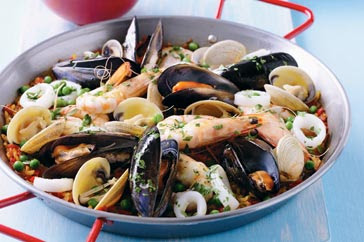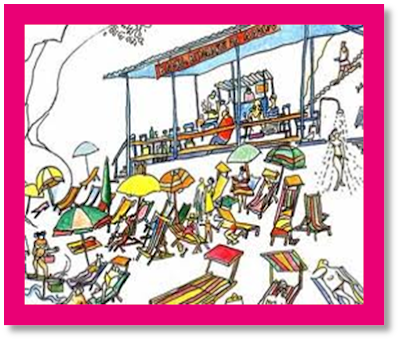
One of the most representative and debated culinary delights of
Spain, Paella can appear before you either in its simplest and possibly
earliest form using only rice, maybe peas or even snails or it can be a delight
of seafood, lobster, langoustine and a combination of seasonal vegetables
including fava beans or artichokes. Paella can also contain chicken, rabbit or
pork but it will almost always contain olive oil, short grain rice, saffron,
tomato, paprika, rosemary, salt and water. Seafood is not usually mixed
with meat or poultry. Traditionally cooked outdoors, often by males, flat based
pans are set up on a tripod over a fire and the ingredients are then added to
the Paella which is the name given to both the pan and the food and using an
uncanny intuition the exact time is judged so that each grain of rice is
perfect, absorbing all the wonderful flavours of the contents of the pan. The
food should heat evenly and the broth should be a subtle reflection of the
ingredients and the aroma from the firewood used to cook the Paella. If the whole family were to share, each would have his or her own
spoon and would take portions directly from the pan. Salad of cut tomato, onion
and oil and vinegar may also be served. It is interesting that the size of the
pan is very important to ensure that the correct amount of rice is used for
example, for 2-3 people you would use a 20-30 cm pan, for 4-5 people a 40-50 cm
pan would be used.
This
wonderful dish has derived from a mixed cultural influence: rice from the Arabs
and the pan from the Romans who took the 2 handled cooking dish with them to
Spain. Paella brings together four basic elements: fire, water, air and earth.
It’s a celebration of the appeasing of hunger and the joy of sharing, leaving
those who eat it with a feeling of abundance and pleasure.
Ingredients (serves 4)
- 1/2 cup (125ml) dry white wine
- 1/2 tsp saffron threads
- 1 tbs olive oil
- 1 Spanish onion, chopped
-
1 red capsicum, seeded, finely chopped
- 2 garlic cloves, crushed
- 1 large ripe tomato, chopped
- 2 tsp mild Spanish paprika
- 1 cup (200g) medium grain rice
- 2 cups (500ml) chicken or seafood stock
- 12 (about 1kg) green king prawns, peeled,
cleaned leaving heads and tails intact
- 2 squid hoods, cleaned, cut into 1cm-thick
rings
- 12 (about 1kg) black mussels, scrubbed,
debearded
- 1kg clams
- 1 cup (150g) frozen peas
- 1/4 cup coarsely chopped flat-leaf parsley
- Lemon wedges, to serve
preparation
1.
Combine wine & saffron in a pan over
low heat & bring to a simmer. Set aside for 5 minutes to allow the saffron
to infuse.
2.
Heat the oil in a large paella or large
frying pan over medium heat. Add onion, capsicum and garlic and cook, stirring,
for 5 minutes or until onion softens.
3.
Add the tomato and paprika and cook,
stirring, for 1 minute or until aromatic. Add the rice, stock and wine mixture
and bring to the boil. Reduce heat to low and cook, uncovered, for 15 minutes
or until rice is almost tender.
4.
Add prawns, squid, mussels and clams and
push lightly into the rice mixture. Cook, covered, for 5 minutes. Sprinkle over
the peas and cook, covered, for a further 2-3 minutes or until prawns change
colour and mussels and clams open.
5.
Remove from heat. Discard any unopened
mussels and clams. Sprinkle with parsley. Serve with lemon wedges.
Cooking tips
Traditionally prepared in an iron paella pan, this dish needs to be
cooked on a large, flat base, as the ingredients need to be in a single layer
to cook evenly. Paella is made with medium grain rice such as Calasparra or Calrose.
Arborio rice can also be used.











